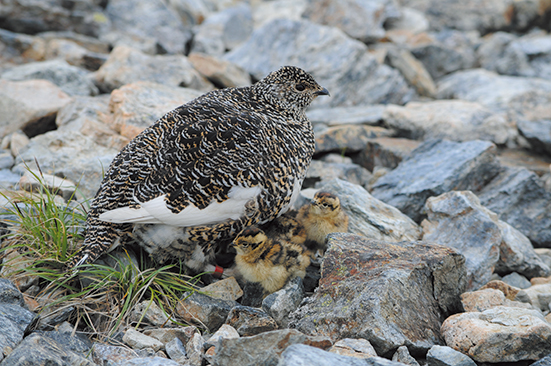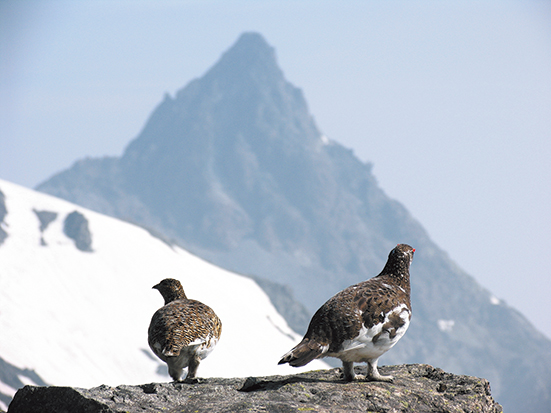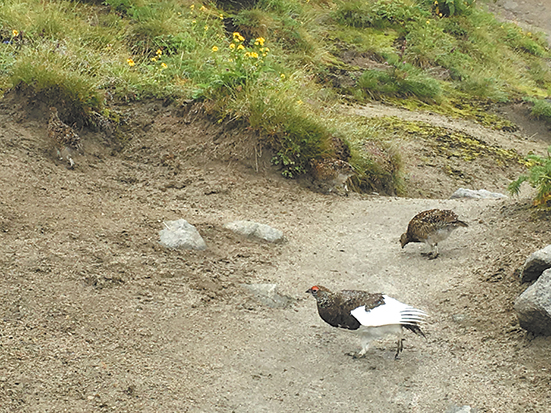【CONTENTS】Rock Ptarmigan seasons

Rock Ptarmigan seasons
March〜April
・When the warmth of the sun shines down on the mountain ridge fellfields and dwarf shrubs, such as crowberries and lingonberries begin to appear, the rock ptarmigan returns to higher elevations after spending the winter at lower ones.
・As the snow continues melting, the males begin their battles over territory.They spread the bright red comb above their eyes and engage in a three-way battle,sometimes fighting to the death.
April〜Early June
・Territories are established from the areas where snow has melted.The still white male sits on a rock and oversees his territory. If an intruder comes along, he flies down to chase it off.
・When the females return to the alpine zone in mid-April, mating season begins. Rock ptarmigan mate with the same partner every year as a general rule. In order to protect the female, the male is always behind the female.
May〜June
・Molting takes place at this time. The all white feathers turn black and white for males and are flecked with white, black, and brown for the females making their genders obvious.
・The females look for a good place to build a nest, generally building one beneath a creeping pine, which stands at a low 30cm in height. Once the nest is finished, the females lays one egg every two or so days.
June〜Mid-July
・Once 6– 7 eggs are laid, the female will incubate them, so they hatch at the same time. Incubation is the female’s job.Excluding the 20 minutes she takes to eat in the morning and evening, she spends her entire day incubating the eggs. The female commits approximately 22 days of her life to incubating the eggs until they hatch.
July〜August
・The chicks hatch from the end of June through the beginning of July. They are able to walk almost immediately, and within a day of hatching they leave the nest and spend the next three months at their mother’s side.
・After the chick hatches, the male no longer behaves territorially and spends his time alone.
・For a month after the chick is born, it warms itself under its mother’s belly as it is still very small and has little ability to regulate its own body temperature.It grows as it forages for the soft buds, leaves, and flowers of lingonberries and crowberries in the windy areas of the mountain.
・Chicks hatch in the rainy season, and as rough weather continues, the chicks cannot yet fly and are targeted by predators. Many chicks die within the first month of life.
Late July〜August
・After about a month, a chick is able to fly a little and can better regulate its own body temperature.
・The remaining snow melts and the soft buds start blooming into flowers and the rock ptarmigan moves to an area called a “Setsuden” or snow field, where they stay as a family until the end of September.
October〜November
・About the time when the first snow falls in early October the chick becomes independent from its mother. It is now a young bird almost the same size as its parents. In this period, mature and young birds gather and form flocks. In larger flocks, there can be as many as 30 birds. Male and females alike molt into duller autumn feathers making them more difficult to distinguish.
November〜December
・As snow accumulates, white feathers start to grow in, and the rock ptarmigan is all white by November. At that time, the birds also plump up.
December〜February
・When the alpine zone is covered in snow, food can no longer be found, so the rock ptarmigan takes up residence below the limit of the forest. Its main food in winter are the winter buds on the Erman’s birch. They also eat the hard leaves of the Maries’ fir.
・At times, the rock ptarmigan dives into the snow to survive the harsh winter and waits for spring as a flock. The winter mortality rate of the rock ptarmigan is actually quite low. This is because they choose a harsh environment where they will not be targeted by predators.



What Rock Ptarmigan eat
They are herbivorous and eat whatever stands out in the season including buds, flowers, leaves, and fruit.
【Summer〜Autumn】
Crowberry, lingonberry, bog bilberry, montane alder, Sorbus matsumurana, creeping pine, Phyllodoce nipponica, alpine bearberry, etc.
【Winter】
Winter buds on Erman’s birch, Maries’ fir leaves, rhododendron leaves, etc.
【Early spring]】
They eat whatever food comes out from the snow.
Rock Ptarmigan predators
All birds of prey Japanese martens, foxes, ermines,crows, etc.
Factors destroying nature
They have a tremendously adverse effect on the vegetation in the alpine region such as the devastation caused by feeding damage to flower fields. The living creatures other than predators that have invaded from the lower mountain regions, such as Japanese deer, wild boar, and the seeds and other organisms originating in lower regions that attach themselves to soles of hikers’ shoes.